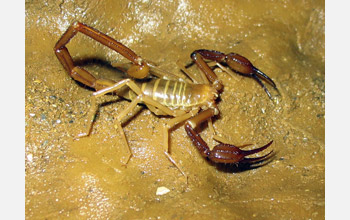Multimedia Gallery
Scorpion Species Alacran tartarus
The scorpion species Alacran tartarus, from the family Typhlochactidae, has been found at the greatest depth of all scorpions--750 to 920 meters below the surface in the Sistema Huautla, Oaxaco, Mexico. [See related image Here.]
More about this Image
In the course of evolution, researchers have assumed that specialized adaptations were irreversible. But research by Lorenzo Prendini, associate curator in the division of invertebrate zoology at the American Museum of Natural History, shows that the evolution of troglobites, or animals adapted for life in caves, is reversible. A new phylogenetic analysis of the family Typhlochactidae found that scorpions currently living closer to the surface (under stones and in leaf litter) evolved independently on more than one occasion from ancestors adapted to life further below the surface (in caves).
The family Typhlochactidae, which includes nine species of scorpions endemic to the karstic regions of eastern Mexico, have adapted to the dark with features such as loss of eyes and reduced pigmentation. Included in the family are one of the world's smallest scorpions, Typhlochactas mitchelli, and the scorpion found at the greatest depth (nearly 1 kilometer below the surface), Alacran tartarus.
For the study, data for 195 morphological characteristics among the species of Typhlochactidae
was gathered and included a detailed mapping of the positions of all trichobothria (sensory setae) on the pedipalps (the second pair of appendages on the first [anterior] major body section). The resulting phylogenetic tree shows that adaptation to life in caves has reversed among this group of scorpions: Two of the less specialized, surface-living species, T. mitchelli and T. sylvestris, share a common ancestor with a much more cave-adapted species, and a similar pattern was found for the third, less-specialized, surface-living species T. sissomi.
Prendini says, "This unique group of eyeless Mexican scorpions may have started re-colonizing niches closer to the surface from the deep caves of Mexico after their surface-living ancestors were wiped out by the nearby Chicxulub impact, along with non-avian dinosaurs, ammonites and other species." [This research was supported in part by National Science Foundation grants EAR 02-28699 and DEB 04-13453.] (Date of Image: 2007-2009)
Credit: P. Sprouse and A. Gluesenkamp
Images and other media in the National Science Foundation Multimedia Gallery are available for use in print and electronic material by NSF employees, members of the media, university staff, teachers and the general public. All media in the gallery are intended for personal, educational and nonprofit/non-commercial use only.
Images credited to the National Science Foundation, a federal agency, are in the public domain. The images were created by employees of the United States Government as part of their official duties or prepared by contractors as "works for hire" for NSF. You may freely use NSF-credited images and, at your discretion, credit NSF with a "Courtesy: National Science Foundation" notation.
Additional information about general usage can be found in Conditions.
Also Available:
Download the high-resolution JPG version of the image. (994 KB)
Use your mouse to right-click (Mac users may need to Ctrl-click) the link above and choose the option that will save the file or target to your computer.



